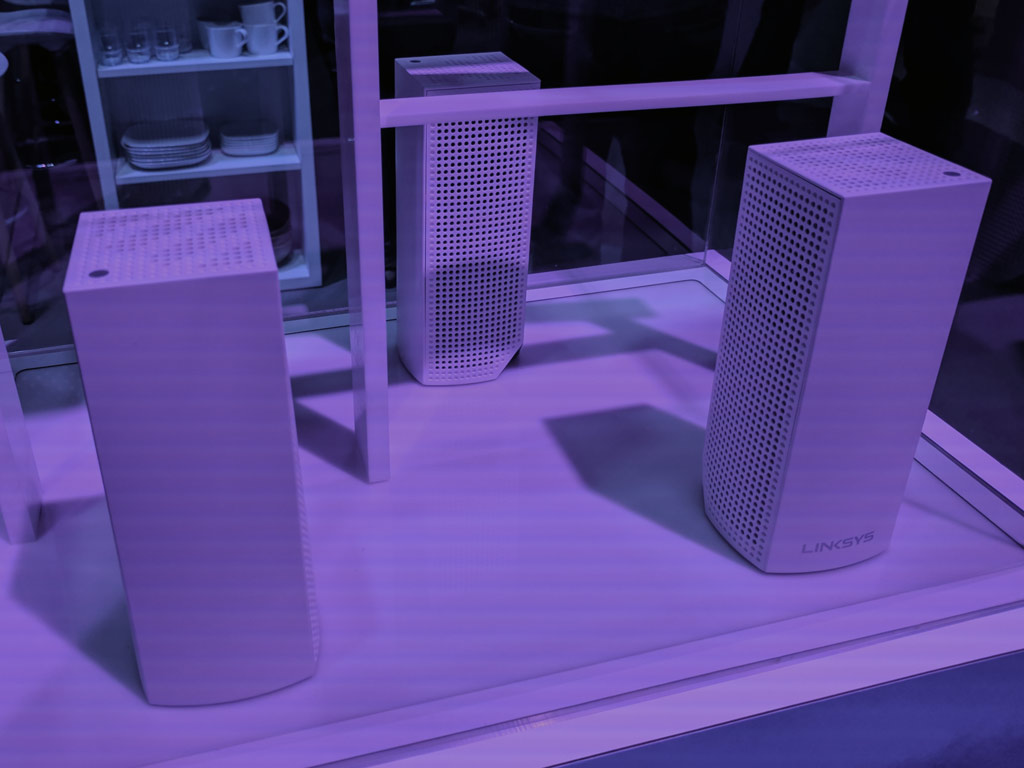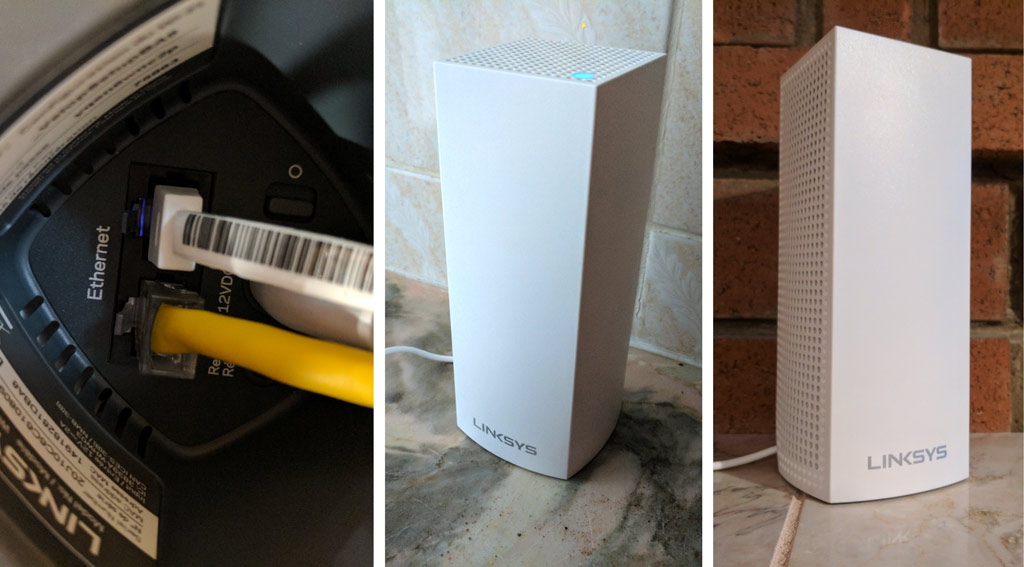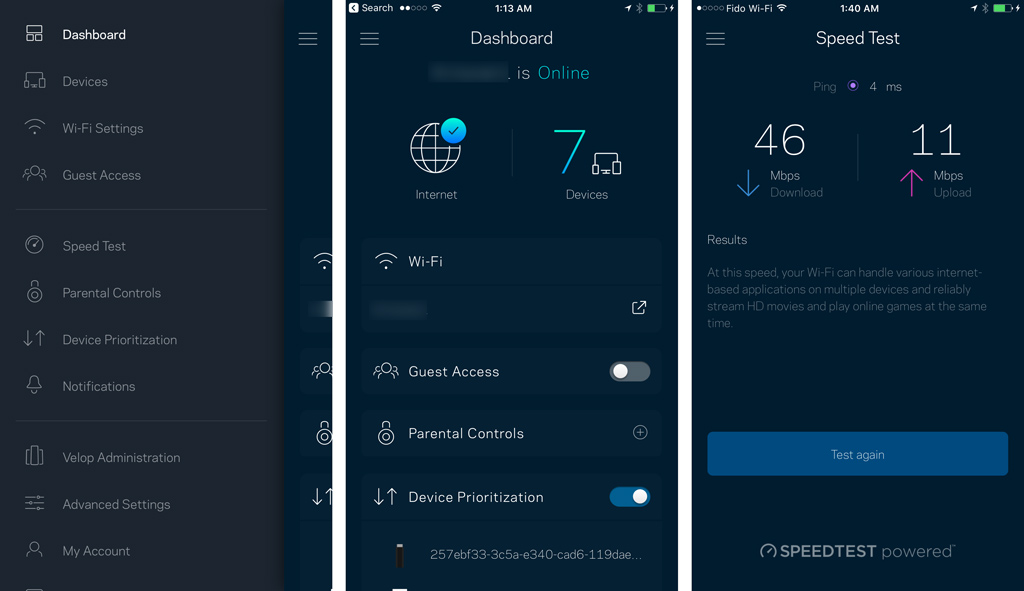
In calling it “Velop,” Linksys has designed this mesh Wi-Fi networking system to envelop a home with better throughput to enable users to get more out of their Internet connection. With easier setup and management courtesy of a newer app, and blanketing performance, this is a router system that delivers as advertised.
Mesh networking is going to be a thing this year, and depending on how large your living space is, you may be inclined to jump in on it. Linksys built the Velop “from the ground up” to not only create a solid router, but to establish a link between the multiple units for a seamless connection in various parts of a home. As good as single routers have become today, waning signal strength and range is a fact of life. Range extenders have helped, but what the Velop does is very different.
Linksys Velop Design
To start off, the Velop comes in three distinct options: a single unit, two-pack or three-pack. The choice amongst these really depends on how much space you are looking to fill. A smaller condo, for example, would probably be fine with just a single unit. A multi-level house, especially with the modem in the basement, could benefit from a two or three-pack.
Each unit in the box is identical, so it doesn’t really matter which one is connected to the modem, and which is set up as a node in another room. The tower design with white paint is a departure from what Linksys has typically done before, and it does make it easier to place them amidst home décor. The upright form factor also simplifies placement, since it doesn’t need a lot of real estate to sit on. One thing Linksys recommends is that each unit be at table-level, so putting a node on the floor may not be the most ideal option.
Underneath each one is a small opening in the corner to snake through cables to the power supply and two Ethernet ports. One disadvantage in going with a design like this is that wired inputs are limited. Smart home devices that use hubs to communicate, like Sonos speakers, Ooma phones, Philips Hue lights and security cameras, need wired inputs. If these hubs are to be in one place, like next to the modem and router, for instance, an Ethernet switch will be required to give you more ports.
Alternatively, you can set up a hub with one of the nodes in another room, since it essentially acts just like the unit connected to the modem does. How flexible or inflexible you find this will really depend on where you want to place the nodes, and if there’s room.
Notably missing from any of the units are USB ports. By removing those, Linksys has negated the use of external hard drives for backups or media servers, though an alternative is to use a network attached storage drive that connects via Ethernet instead. It won’t matter who makes it. As long as it can plug in and be seen on the network, you will be good to go.
Each node is designed to cover up to 2,000 sq. ft., so a three-pack could conceivably cover 6,000 sq. ft. total. The Velop isn’t limited to three because it can support extra nodes added to it. Inside, each one has six antennas, with tri-band functionality built-in to cover both the 2.4GHz and two 5GHz bands. They also each support MU-MIMO (multi-user, multi-input, multi-output), which funnels bandwidth simultaneously to devices, rather than in a sequential on-demand queue. It’s not something you would have noticed up to this point, but one reason buffering happens is because that device had to wait its turn.

Velop Setup
Router setup has improved dramatically in only the last two years, and the Velop follows that trend. Linksys redesigned its iOS and Android app to accommodate the new system, so once the first unit is plugged in, the app will recognize it and initiate the step-by-step guide to get it up and running.
In keeping with current trends, the setup is designed for smartphones and tablets, rather than computers. Within five minutes, everything should go smoothly. The app does want to know whether you are graduating from a modem/router combo device (which is common from Internet Service Providers) or a dedicated router that is connected to a modem. Once I had the Wi-Fi name and password done, the app took it from there.
One catch is that setting up the extra units as nodes does require some patience. Nodes can always be added when the main unit (connected to the modem) is already set up, and conventional wisdom is that a node should be placed one floor above the unit before it. The app can measure the strength of the signal there, and if it’s not good enough, it won’t go through with the setup. That takes any guesswork out of knowing whether a location is good or not, but can get a little annoying when even a couple feet can make a difference. Simplifying things further, each node can be assigned a certain room in the app, so that way you know which one to refer to in case there’s an issue.
One thing to note in all this is that the Wi-Fi network setup doesn’t distinguish between the different bands, and the reason for that is what’s called band-steering. In basic terms, the Velop assigns devices to the bands that correspond with their respective need for bandwidth. All you have to do is just log in each device and let it go from there.
While the app has gone through a bit of a makeover, it’s still fairly straightforward. Setting up a guest network is easy, and you can choose to manually turn it on or off when you have a visitor, instead of keeping it on all the time. Device Prioritization allows for up to three devices to get preferential treatment for bandwidth. Parental Controls can totally restrict a device’s access to the Internet, and block up to 10 websites. Restricting a device on a schedule can only be done through the web browser dashboard, not through the app.
Speed Test uses Ookla’s service to gauge how fast your connection is. Advanced settings, especially in the app, aren’t going to be deep enough to impress networking experts, but at least port forward and MAC filtering are in there. There’s more in the browser interface.
Velop Performance
What’s uniquely different about how the Velop works is that each unit acts like a router, so there is no ‘handoff’ requiring a separate login to a range extender. To put it bluntly, this was the best router experience I’ve had when it comes to consistent range within a home.
Don’t get me wrong, I’ve tested excellent routers, including for this blog, but the whole point of the Velop is that it isn’t really just one router. In having three units spread out in a home that is about 1,900 sq. ft. I was able to get almost full bandwidth in each room a node was placed in. What stood out even more, though, was the way the connection spread out from each node.

For example, the router was in the basement, one node in a family room one level above, with the last node in the living room above that. Any point in between those all but ensured I got really fast output. The further I ventured away from each node, the more the signal started to dissipate, but it was less than it would’ve been if it was only one router covering the same space. That’s not to say that I wouldn’t have been able to connect in that scenario, only that the Velop was able to deliver better throughput because I was technically closer to the router based on the way mesh works.
Signal loss was only 50% in the furthest corners on the top floor of the house, or while outside. Outside spots that used to struggle didn’t now because of the closer proximity afforded by the notes.
In fairness, the three-pack was probably overkill for the size of the house. Two would have done the job just fine. Unless it was an older home with less porous walls, homes 2,000 sq. ft. or less wouldn’t need a three-pack to cover that space. Single units are also more than enough for condos, unless you live in a large one.
MU-MIMO is a factor here too, though not as many devices support it yet. That is likely to change with this year’s crop of new smartphones, tablets, laptops and other connected devices. For now, there are USB adapters for Windows PC computers enabling compatibility and a smattering of other devices. New smartphones and tablets launching this year are expected to support it much more.
Velop offers a solid Mesh Wi-Fi experience
The Velop was made for users who want solid Wi-Fi throughput, and don’t care as much about the physical constraints on the devices themselves. The lack of USB and Ethernet LAN ports on each unit would be immaterial if you only want solid wireless connectivity with one or two devices plugged through LAN (note that the LAN ports on the nodes are active too, so you can make use of them).
If you are more demanding as a network administrator, and like what the Velop can do, bear in mind that you would need to get a switch for more LAN ports, while figuring out a way around the lack of USB. As a mesh networking system, the Velop impressed me, and I suspect it would have benefits for smart home devices too.
The Linksys Velop Wi-Fi System is available now in a 3-pack or 2-pack.



